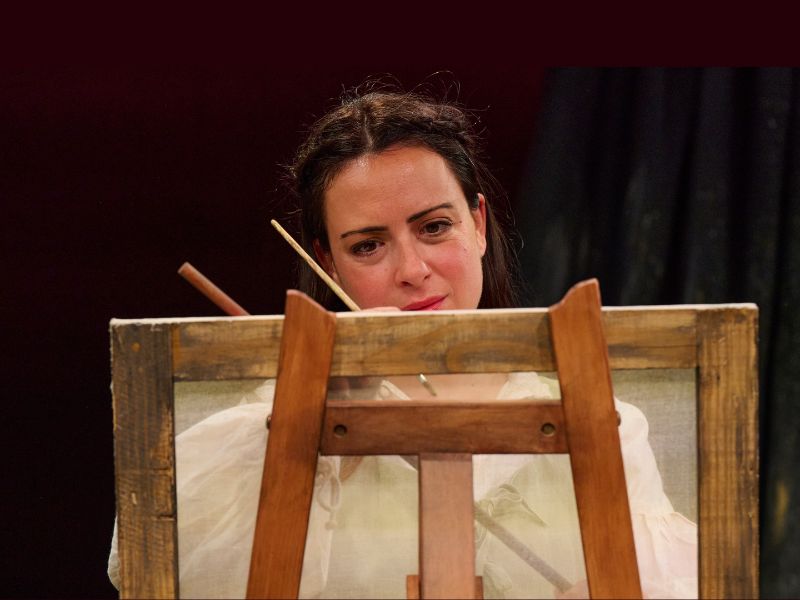At first in WSG’s irresistible comedy, Sofonisba Anguissola (Amanda Tudor) is under interrogation. The stern but in his own eyes fair Bishop Espinoza (Peter Boyer) is gauging her possible fitness as a lady-in-waiting to Queen Isabel (O’Malley Steuerman) at the 16th-century Spanish court of the Catholic Philip II (Gabriel Alejandro). Philip, who once was married to the late Queen Mary, sister of Elizabeth I, now has a teenage French Queen who will need sensitive attendants.
Sofonisba, already a notable painter, is eager for the assignment. Relations between her native land, Italy, and Spain are somewhat difficult. She has lost her mother, although her father’s support and encouragement have helped her career. The court will be a crucial chance for her.

Queen Isabel, whom she serves, becomes a treasured friend. Here they are playing chess. (One of Sofonisba’s most famous paintings is called The Chess Game, and it features her and her sisters.)
SOFONISBA: The Queen is the most powerful piece on the board.
ISABEL: That is the opposite of the truth.
[Isabel moves her queen.]
And what if I do this, Eh Sofie? Tell me what it is I have done wrong, because I cannot seem to make a right move.
SOFONISBA: Well, you certainly can move your Queen there if you wish, Your Majesty…buuuut…if you do…
ISABEL: Oui what tell me.
SOFONISBA: Then your Bishop is open. So…I could take your Bishop. If I wanted. But I might not want, of course, so it’s really a perfectly fine move for you to have made.
[ISABEL immediately moves the piece back.]
ISABEL: No. No. No. No. No. We must protect God’s man.
…This game is false. The Bishop, as an emissary of God, should be most important. This is obviously a Protestant game.
The chemistry between Steuerman as the flighty, charming Queen and Tudor as the clever, smiling Sofonisba is exceptional. Both are in the process of creation. Sofonisba, promised to her art, faces questions about her desire to marry, or lack of it. Isabel, like so many other queens of her era, is under intense pressure to deliver Philip a son.
Tudor’s Sofonisba is naturally warm and gracious. She dresses plainly, to convey seriousness. But she can be lively too. When Bishop Espinoza offers her the post of lady-in-waiting, she jumps up and down with excitement. Her special strength is her firm decision to run her life as she wants to, not as society seems to think is her duty.

Steuerman’s performance as Queen Isabel is inspired and intuitive. They cock their head, laugh, and whizz around the stage, very much like the “chatterbird” Isabel admits she is. And when Isabel prays desperately for a son, Steuerman’s emotional depth is formidable.
Peter Boyer displays great versatility in three different roles. As the Bishop, he is careful and cautious. As the Fool, he is wildly funny. Here he is with Isabel:
FOOL: I have learned many important things in my time at court, Queenie.
ISABEL: Oui? Name three!
FOOL: There are three ways to get what you want in this world: to lack morals, to speak very important nonsense, and, when all else fails, to walk on your hands.
[He does a handstand.]
That may or may not be true.
As Don Francisco, the stuttering, well-born, devoted suitor of Sofonisba, Boyer is shy and sincere.
Gabriel Alejandro’s Philip is very much in love with Isabel, and he enjoys posing for Sofonisba. As he surveys his portrait, he tells her, “The leg is very good. Full.” It is a pleasure to see a king (Philip was actually said to be somewhat solemn) with a sense of humor. His later scenes with Sofonisba contain some explosive accusations on both sides — but ultimately, it is clear he believes he is only trying to help. The Spanish Inquisition, understandably, is rarely mentioned.
Callie Kimball’s writing is supple and witty. Deidra LaWan Starnes’ direction is assured and accomplished. Every aspect of the production is imaginative and truthful.
Elizabeth Morton’s costumes are lovely, colorful, and full of exquisite detail. Thom J. Woodward’s sound design features melodic accents of the Spanish guitar.
Megan Holden designed the scenic elements, and Marianne Meadows designed the lighting. Both enhance the impact of the work.
The play is framed by two scenes on ships: At first, we see Sofonisba, full of anticipation, on the way from her home in Cremona to the Spanish court. Twenty years later, she is on another ship, with a handsome captain, Orazio (Gabriel Alejandro). She is on her way to another happy chapter of what seems to be a charmed life. But she also achieved something extraordinary. She opened up the profession of painting to the women of her time and made it socially acceptable. Her story is a compelling one.
Running Time: Two hours, with one 10-minute intermission.
Sofonisba plays through May 4, 2025, presented by Washington Stage Guild performing at The Undercroft Theatre at Mount Vernon Place United Methodist Church, 900 Massachusetts Avenue NW, Washington, DC. Prices are $50 for Thursday evening performances and Saturday and Sunday matinees, and $60 for Saturday evenings. Students are half-price, and seniors over 65 get a $10 discount. Tickets can be purchased online.
Cast and creative credits are here.
COVID Safety: Masks are recommended (not required). Washington Stage Guild’s complete Health and Safety Policy is here.
Sofonisba
By Callie Kimball
Directed by Deidra LaWan Starnes
Artistic Director: Bill Largess
Associate Artistic Director: Steven Carpenter
CAST
Sofonisba Anguissola: Amanda Tudor
King Philip II, Orazio: Gabriel Alejandro
Queen Isabel: O’Malley Steuerman
Bishop, Don Francisco, Fool: Peter Boyer
CREATIVE AND PRODUCTION TEAM
Scenic Design: Megan Holden
Costume Design: Elizabeth Morton
Lighting Design: Marianne Meadows
Sound Design: Thom J. Woodward
Stage Manager: Shannon Viridian
Assistant Stage Manager: Luca Maggs
